Click on the small image for a larger JPEG.
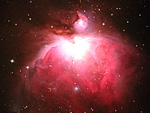 | The Great Nebula in Orion
M42, NGC1976 25 minute exposure on hypered Kodak PJM-2 film.
Exposure begun at UT = Oct 4, 1997 10:37
Sapello, NM 105°17'E, 35° 44'N.
Takahashi CN212 Cassegrain, 8.34" aperture at f/9.9.
Takahashi EM200 mount. ST-4 autoguider on 90mm f/13 Meade Maksutov-Cassegrain.
|
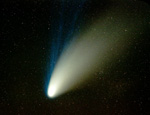 | Comet Hale-Bopp in Perseus
The open cluster M34 is visible center right. 3 minute exposure on hypered Fuji 100 Super G Plus.
Wratten #1A filter.
Exposure begun at UT = April 8, 1997, 01:31
Bisher Farm, Spruce Run, New Jersey
Celestron-Epoch Schmidt Camera, 8" aperture at f/1.5.
Takahashi EM200 mount, unguided tracking of comet using Tomita drive corrector.
|
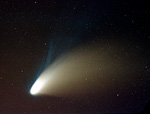 | Comet Hale-Bopp in Taurus
The comet is now low on the horizon and fighting twilight. 3 minute exposure on hypered Fuji 100 Super G Plus.
Wratten #1A filter.
Exposure begun at UT = April 26, 1997, 23:40
Promised Land State Park, Poconos, PA
Celestron-Epoch Schmidt Camera, 8" aperture at f/1.5.
Takahashi EM200 mount, unguided tracking of comet using Tomita drive corrector.
|
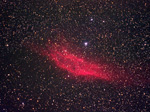 | California Nebula in Perseus
NGC1499 7 minute exposure on hypered Kodak PPF400 film.
Wratten #1A filter.
Exposure begun at UT = Sept 30, 1997, 07:40
Sapello, NM 105°17'E, 35° 44'N.
Celestron-Epoch Schmidt Camera, 8" aperture at f/1.5.
Takahashi EM200 mount, unguided sidereal tracking.
|
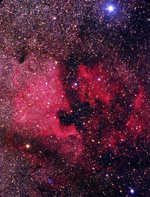 | North American and Pelican Nebulae in Cygnus
NGC7000 & IC5070.Includes the open clusters NGC6996 & NGC 6997.
Deneb is the bright blue star at the top.
The small blue feature at the bottom left of center, is a secondary image of Deneb,
reflected off the film, then off the curved corrector plate back to the film. 5 minute exposure on hypered Kodak PJM-2 film.
Wratten #1A filter.
Exposure begun at UT = Oct 1, 1997, 03:43
Sapello, NM 105°17'E, 35° 44'N.
Celestron-Epoch Schmidt Camera, 8" aperture at f/1.5.
Takahashi EM200 mount, unguided sidereal tracking.
|
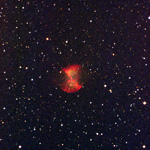 | The Dumbell Nebula in Vulpecula
M27, NGC1976 45 minute exposure on hypered Kodak PJM-2 film.
Exposure begun at UT = Oct 3, 1997, 02:10
Sapello, NM 105°17'E, 35° 44'N.
Takahashi CN212 Cassegrain, 8.34" aperture at f/9.9.
Takahashi EM200 mount. ST-4 autoguider on 90mm f/13 Meade Maksutov-Cassegrain.
|
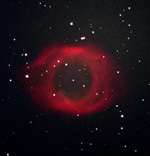 | The Helix Nebula in Aquarius
NGC7293. This impressive nebula subtends about half the angular diameter of the moon. 75 minute exposure on hypered Kodak PJM-2 film.
Exposure begun at UT = Oct 2, 1997, 04:49.
Sapello, NM 105°17'E, 35° 44'N.
Takahashi CN212 Cassegrain, 8.34" aperture at f/9.9.
Takahashi EM200 mount. ST-4 autoguider on 90mm f/13 Meade Maksutov-Cassegrain.
|
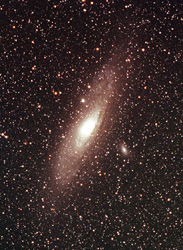 | The Great Andromeda Galaxy
M31, NGC224. Includes the galaxies M32, NGC221 (above) and M110, NGC205 (below). 5 minute exposure on hypered Fuji 100 Super G Plus.
Wratten #1A filter.
Exposure begun at UT = Sept 29, 1997, 05:55
Sapello, NM 105°17'E, 35° 44'N.
Celestron-Epoch Schmidt Camera, 8" aperture at f/1.5.
Takahashi EM200 mount, unguided sidereal tracking.
|
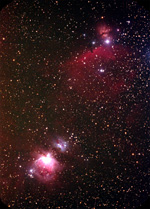 | The Central Orion region
Includes the M42, M43, Horsehead and Flame nebulae. 5 minute exposure on hypered Kodak PJM-2 film.
Wratten #1A filter.
Exposure begun at UT = Oct 4, 1997, 09:32
Sapello, NM 105°17'E, 35° 44'N.
Celestron-Epoch Schmidt Camera, 8" aperture at f/1.5.
Takahashi EM200 mount, unguided sidereal tracking.
|
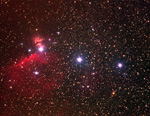 | Orion's "Belt"
Includes the Horsehead and Flame nebulae,
as well as the distinctive blue stars, Alnitak, Alnilam and Mintaka. 5 minute exposure on hypered Kodak PJM-2 film.
Wratten #1A filter.
Exposure begun at UT = Oct 4, 1997, 09:39
Sapello, NM 105°17'E, 35° 44'N.
Celestron-Epoch Schmidt Camera, 8" aperture at f/1.5.
Takahashi EM200 mount, unguided sidereal tracking.
|
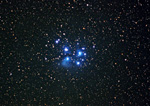 | The Pleaides, the "Seven Sisters", in Taurus
The Pleaides (M45) are actually an open cluster of about 100 stars
which are enshrouded by the blue reflection nebula I349. 7 minute exposure on hypered Kodak PPF 400 film.
Wratten #1A filter.
Exposure begun at UT = Sept 30, 1997, 05:39
Sapello, NM 105°17'E, 35° 44'N.
Celestron-Epoch Schmidt Camera, 8" aperture at f/1.5.
Takahashi EM200 mount, unguided sidereal tracking.
|
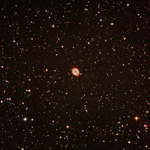 | The Ring Nebula in Lyra
M57. 45 minute exposure on hypered Kodak PJM-2 film.
Wratten #1A filter.
Exposure begun at UT = Oct 3, 1997, 03:17
Sapello, NM 105°17'E, 35° 44'N.
Takahashi CN212 Cassegrain, 8.34" aperture at f/9.9.
Takahashi EM200 mount. ST-4 autoguider on 90mm f/13 Meade Maksutov-Cassegrain.
|
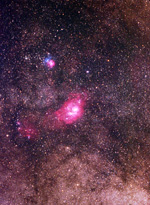 | The Lagoon (M8, center) and Triffid (M20, upper left) Nebulae in Sagittarius
The open cluster M21 is also visible to the left of M20.
The dense, optically opaque, center of the Milky Way is to the lower right. 7 minute exposure on hypered Kodak PPF 400 film.
Wratten #1A filter.
Exposure begun at UT = Sept 29, 1997, 00:39
Sapello, NM 105°17'E, 35° 44'N.
Celestron-Epoch Schmidt Camera, 8" aperture at f/1.5.
Takahashi EM200 mount, unguided sidereal tracking.
|
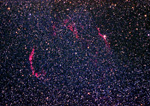 | The Veil Nebulae in Cygnus
7 minute exposure on hypered Kodak PJM-2 film.
Wratten #1A filter.
Exposure begun at UT = Oct 1, 1997, 04:43
Sapello, NM 105°17'E, 35° 44'N.
Celestron-Epoch Schmidt Camera, 8" aperture at f/1.5.
Takahashi EM200 mount, unguided sidereal tracking.
|
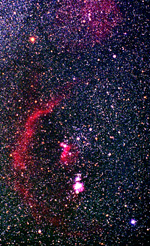 | The Constellation Orion
The Great Orion nebula, the Horsehead nebula and Barnard's Loop are visible. 2 minute exposure on hypered Kodak PJM-2 film.
Exposure begun at UT = Oct 4, 1997 11:31
Sapello, NM 105°17'E, 35° 44'N.
Nikon N90s; Noct-Nikkor f/1.2 lens, piggy-backed on a
Takahashi CN212 Cassegrain,
Takahashi EM200 mount, unguided sidereal rate. |
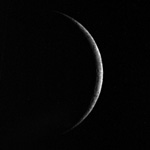 | Crescent moon, 2 days old
The moon is low on the horizon, which is toward the lower right. The "seeing" is poor. ~1/2 second exposure on unhypered TP2415.
Exposure taken at UT = Oct 14, 1996 20:29
Princeton, New Jersey, 74°37.5'W 40°21.0'N Questar 3.5" aperture at f/16.
Questar Powerguide II, tracking at lunar rate.
A black card, waved in front of the telescope, was used as a vibration-free shutter.
|
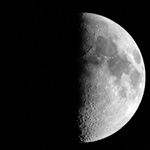 | First Quarter, 8 days old
~1/6 second exposure on unhypered TP2415.
Exposure taken at UT = July 24, 1996 02:25
Princeton, New Jersey, 74°37.5'W 40°21.0'N Questar 3.5" aperture at f/16.
Questar Powerguide II, tracking at lunar rate.
A black card, waved in front of the telescope, was used as a vibration-free shutter.
|
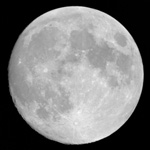 | Night Before Full Moon, 14 days old
The following night the true Full Moon was eclipsed, however Princeton was clouded out!. ~1/6 second exposure on unhypered TP2415.
Exposure taken at UT = Sept 26, 1996 02:12
Princeton, New Jersey, 74°37.5'W 40°21.0'N Questar 3.5" aperture at f/16.
Questar Powerguide II, tracking at lunar rate.
A black card, waved in front of the telescope, was used as a vibration-free shutter.
|
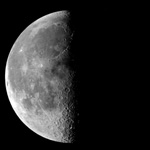 | Last Quarter, 23 days old
~1/4 second exposure on unhypered TP2415.
Exposure taken at UT = July 7, 1996 07:28
Princeton, New Jersey, 74°37.5'W 40°21.0'N Questar 3.5" aperture at f/16.
Questar Powerguide II, tracking at lunar rate.
A black card, waved in front of the telescope, was used as a vibration-free shutter.
|
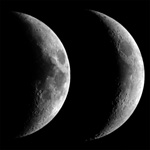 | Lunar Librations
Relative to an observer on Earth, the moon appears to wobble.
This wobble is caused by parallax artifacts due to the rotation of the Earth,
the elliptical orbit of the moon, and the fact that the moon's orbit
is inclined at about 6° to the ecliptic.
Consequently, about 59% of the moon's surface can be observed from Earth (but not all at once!).
Mare Crisium is visible in both images, but Mare Fecunditatis
has rotated across the terminator in the right-hand image.
~1/3 second exposures on unhypered TP2415.
Left: UT = July 4, 1995 01:35, waxing crescent, 6 days old
Right: UT = Dec 6, 1994 23:35, waxing crescent 4 days old
Princeton, New Jersey, 74°37.5'W 40°21.0'N Questar 3.5" aperture at f/16.
Questar Powerguide II, tracking at lunar rate.
A black card, waved in front of the telescope, was used as a vibration-free shutter.
|
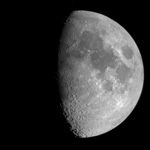 | Waxing gibbous, 9 days old
The "seeing" was much better than usual that night.
The air was probably stabilized by the lake. ~1/4 second exposure on unhypered Ilford Pan-F plus.
Exposure taken at UT = Nov 12, 1994 00:15
Lake Wallenpaupack, Poconos, PA, 75°13'W 41°28'N Questar 3.5" aperture at f/16.
Questar Powerguide II, tracking at lunar rate.
A black card, waved in front of the telescope, was used as a vibration-free shutter.
|
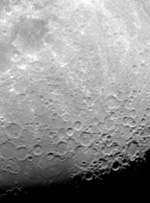 | Waxing gibbous, 9 days old
Detail from the previous image. The linear feature known as
"The Wall" is well-defined near the terminator (bottom, left of center). ~1/4 second exposure on unhypered Ilford Pan-F plus.
Exposure taken at UT = Nov 12, 1994 00:15
Lake Wallenpaupack, Poconos, PA, 75°13'W 41°28'N Questar 3.5" aperture at f/16.
Questar Powerguide II, tracking at lunar rate.
A black card, waved in front of the telescope, was used as a vibration-free shutter.
|
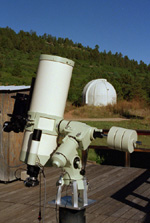 | My Takahashi CN212 on EM200 mount
Taken at Star Hill Inn, Sapello, New Mexico.
10/4/97 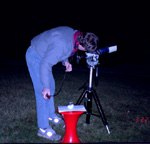 | My Questar
Back yard, Princeton, New Jersey,
During early efforts to photograph the moon.
3/22/94 | 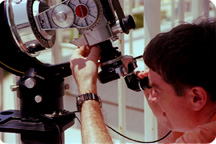 | My Questar
Hotel Balcony, Aruba,
During early stages of the solar eclipse.
2/26/98 | |
























